LPG FAQs
How does LPG work?
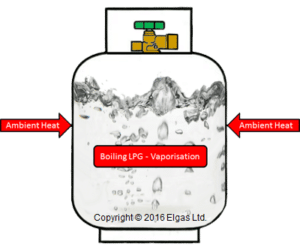 LPG – Liquefied Petroleum Gas – is stored under pressure as a liquid in a gas cylinder.
LPG – Liquefied Petroleum Gas – is stored under pressure as a liquid in a gas cylinder.
It turns back into a gas when you release some of the pressure in the gas cylinder by turning on your appliance.
The LPG boils when it vaporises – turns back into gas – by drawing heat from the bottle walls. (see image)
A regulator ensures a consistent pressure is safely delivered from the gas cylinder to your appliances.
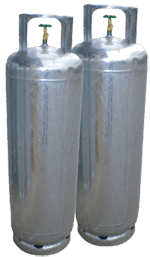 How many LPG gas cylinders do I need?
How many LPG gas cylinders do I need?
We provide most homes with two 45kg gas cylinders.
With two gas cylinders, you call to order as soon as one cylinder is empty, while continuing to use the other cylinder.
This gives you an uninterrupted supply of gas. Watch VIDEO for how to change over between cylinders.
How are the gas cylinders connected to my home?
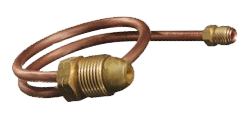 The gas cylinders are connected by tubing, known as “pigtails”, to a changeover valve and the changeover valve is connected to a regulator.
The gas cylinders are connected by tubing, known as “pigtails”, to a changeover valve and the changeover valve is connected to a regulator.
A gas line then runs from the regulator to your appliances.
The changeover valve controls which gas cylinder is in use. For more info, please see the image HERE.
Get $100 in LPG Account Credits!
Choice of 2-Year Fixed or Variable 45kg Gas Bottle Price
No Lock-in Contracts
We return your old gas bottles for you
It is a great time to switch to ELGAS
How to order LPG & what to do if my property already has cylinders?
• If your property has never had LPG you’ll have to request for a fresh installation
• If your property already has cylinders you can simply reorder.
• If your property has a connection but no cylinders you can either take your ELGAS connection with you or order afresh.
For all options access our MOVING HOME page.
How do I make sure I don’t run out of gas?
Always order gas as soon as the first cylinder runs out.
Don’t wait until the gas cylinders are both empty or near empty.
Follow this advice and you are virtually assured to never run out of gas.
 Remember to check your gas cylinders more often in cold weather or when you have additional house guests.
Remember to check your gas cylinders more often in cold weather or when you have additional house guests.
If you only have one gas cylinder attached to your home, you may wish to consider adding a second gas cylinder.
This is particularly wise if you use it for hot water and/or heating.
Be certain to tell us if you install additional appliances, especially if you are on automatic tanker delivery, so we can adjust your delivery schedule.
How do I know how much gas is left?
Carefully pour a cup of hot water down the side of the cylinder and a line of condensation should appear at the level of the remaining gas.
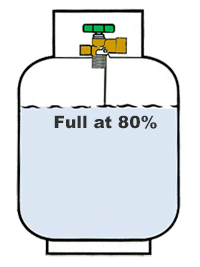 If no line is apparent, you can also wait a few seconds and run your hand down the cylinder.
If no line is apparent, you can also wait a few seconds and run your hand down the cylinder.
It will feel cool to the touch at the level of the gas.
If you see no line and feel no difference in temperature, chances are the cylinder is empty. Remember to always use care with the hot water.
Also, please be aware that gas cylinders are designed to be full at 80% or just over 3/4.
The cylinders are oversized so you get the full measure of gas.
The unfilled space, called “ullage”, allows for the natural expansion of the gas during warmer temperatures.
How often should I check my gas cylinders?
That all depends on the type and number of appliances, your climate, the number of people in your home and how often you use the appliances.
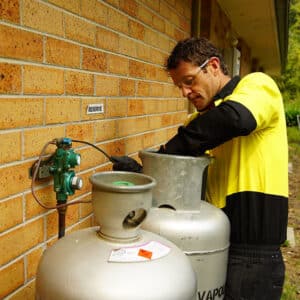 The following maximum time intervals are based on averages and assume that you are starting with full gas cylinders:
The following maximum time intervals are based on averages and assume that you are starting with full gas cylinders:
- Cooking only – Every 9 to 12 months
• Hot water only – Every 2-3 months depending on climate and the number of people in your home.
• Heater only – Every month during heating season or more often with large or multiple units and in colder climates.
• Combinations of the above – Every month or more often during heating season with large or multiple units and in colder climates.
What if the gas isn’t working?
Check to make sure the active gas cylinder is turned on. The active gas cylinder is the one pointed to by the changeover valve.
Check to see if either gas cylinder has any gas left, using the hot water test.
If so, you may need to switch to the full gas cylinder with the changeover valve.
If both cylinders are empty, please contact us for a gas delivery and make sure you tell us you need two gas cylinders.
What if there is a gas leak?
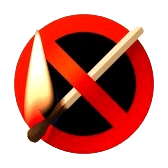 In the unlikely event that you have a gas leak, turn off the cylinder valve(s) by rotating clockwise.
In the unlikely event that you have a gas leak, turn off the cylinder valve(s) by rotating clockwise.
You should also call the ELGAS emergency response number on 1800 819 783.
As an added precaution, make sure the area is well ventilated to disperse any gas, and remove or turn off all flames and other sources of ignition.

